
Dry eye syndrome can be more than a minor annoyance; it can disrupt your life and health. Whether you are experiencing occasional discomfort or persistent symptoms, finding the proper treatment can make all the difference.
Understanding Dry Eye
This problem occurs when your eyes fail to produce adequate tears or when the tears evaporate too quickly. Redness, burning, itching, and light sensitivity can occur. If left untreated, dry eye may affect your vision. It is essential to address these symptoms promptly to avoid potential complications and maintain your eye health.
Diagnosis
To diagnose dry eye, your eye doctor will ask questions and examine your eyes. They will use tests and tools to measure your tears and check your eye health. For example, they may use:
The Schirmer test to see how much your eyes wet a paper strip.
The tear breakup time test to see how long your tears last after blinking.
The keratometer is used to observe the shape of your cornea.
The slit lamp microscope to see the surface of your eye.
Exploring Treatment Options
The cause of your condition and severity of symptoms will determine the treatment for dry eye syndrome. Some of the standard treatment options include:
Artificial Tears
These lubricating eye drops can help moisten your eyes and relieve dryness. They are available over-the-counter or by prescription. Your needs may require everyday use.
Punctal Plugs
Punctal plugs are tiny devices that eye doctors insert into the openings of your tear ducts. They actively block the drainage of tears, allowing more tears to stay in your eyes and reducing dryness. Typically made of silicone or collagen, they can be temporary or permanent solutions.
Prescription Medications
Some medications can help treat the underlying cause of dry eye or reduce inflammation and pain. For example, cyclosporine and lifitegrast are eye drops that can increase tear production by stimulating the immune system. Steroid eye drops can also help reduce inflammation and swelling in the short term.
Lipiflow
The device applies heat and gentle pressure to unclog the meibomian glands, improving tear quality. You place the device over your eyes for about 12 minutes. It can provide lasting relief for dry eye caused by meibomian gland dysfunction.
Intense Pulsed Light (IPL)
This treatment utilizes pulses of light to actively target the blood vessels and nerves around your eyes, reducing inflammation and dryness. The light also stimulates the production of collagen and elastin. This enhances the health and elasticity of your eyelids and tear glands.
Surgery
In severe cases, surgery may be necessary to treat dry eyes. Corrective surgery may be essential to prevent eye irritation if you have ectropion or entropion, which causes your eyelids to turn outward or inward. Tarsorrhaphy is another surgery that can help with dry eye by stitching the edges of your eyelids together. This reduces exposure to air and evaporation.
Conclusion
Dry eye can impact people of all ages. Although prevalent, it is a treatable condition. Many treatments can alleviate the symptoms and improve your quality of life. Discuss with your eye doctor today to discover the most suitable solution.
For more on dry eye syndrome, visit EyeXcel at our Knoxville, Tennessee, offices. Call (865) 687-1232 or (865) 243-8260 to schedule an appointment today.










